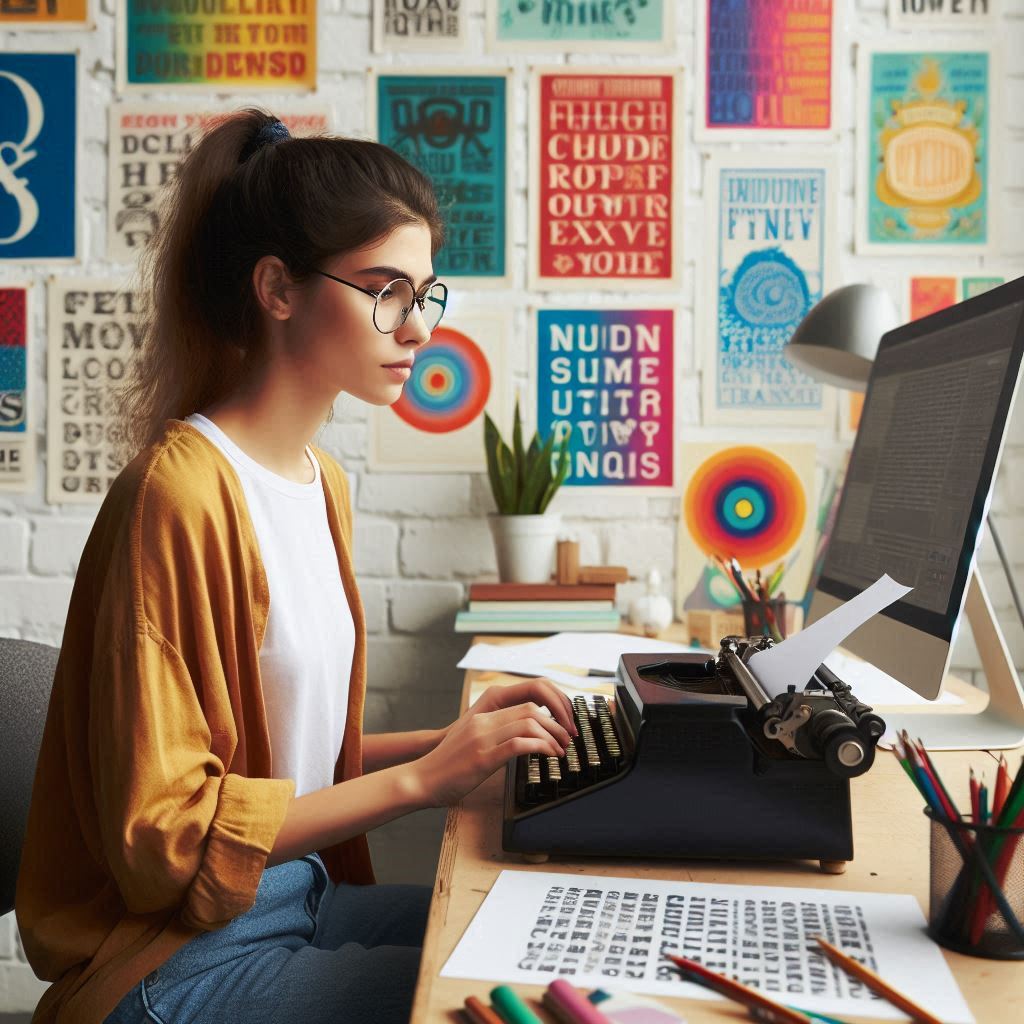Introduction
Typography is more than just the arrangement of letters; it’s the backbone of design and communication, influencing how information is delivered and perceived.
Every curve, weight, and spacing choice in a typeface can evoke emotion, set a mood, and define a brand‘s identity.
Whether in advertising, websites, or print media, typography can make or break the effectiveness of a message.
The strategic use of type not only guides readers through content but also leaves a lasting impression, reinforcing the message or diluting it if done poorly.
In today‘s design-driven world, understanding the art and science of typography is crucial for anyone looking to communicate visually.
That‘s why we‘re turning to the expertise of a professional typographer for insights into this powerful craft.
In this interview, we‘ll explore the intricate process of selecting the right fonts, balancing form and function, and how typography shapes user experience.
We‘ll also uncover industry tips and trends that can help elevate your next project.
Whether you’re a graphic designer, marketer, or simply curious about design, this interview offers a deep dive into how expert typographers think and work.
You’ll gain practical knowledge about the principles that define great typography, from readability to emotional impact, and learn how it can influence the way your audience interacts with your content.
Background of the Professional Typographer
Introduce the Professional Typographer Being Interviewed
Sarah Mitchell, a renowned typographer, has dedicated over 15 years to perfecting the art of type design.
Her journey began in her childhood, where a fascination with letterforms sparked her interest in typography.
After earning her degree in graphic design, she immersed herself in the world of type, exploring how letters can shape visual communication.
Today, Sarah stands as a prominent figure in the industry, known for her innovative approach and creative vision.
Provide Information About Their Experience and Expertise in Typography
With extensive experience in both print and digital typography, Sarah’s expertise lies in creating elegant, highly readable typefaces.
She has worked across various mediums, adapting her designs to meet the needs of each project.
Her keen eye for detail and understanding of typographic principles enable her to craft designs that resonate with audiences.
Sarah also focuses on the emotional impact of typography, believing that the right type can enhance a message and create a lasting impression.
In her career, she has collaborated with top-tier brands and design studios, influencing the typography world with her distinctive style.
She is well-versed in modern design trends and often experiments with new techniques and technologies to stay ahead in the field.
Her work reflects a deep appreciation for both traditional craftsmanship and contemporary design practices.
Mention Any Notable Projects or Collaborations They Have Been Involved In
Sarah has been involved in numerous notable projects throughout her career, collaborating on global campaigns for brands like Apple and Nike.
Her partnership with famed designer Paula Scher stands out, where they crafted a unique font family for an international brand identity.
This collaboration not only showcased their combined expertise but also resulted in a typeface that has become iconic in marketing.
Additionally, Sarah has contributed to several award-winning projects that emphasize the importance of typography in visual storytelling.
Her work has received multiple accolades, further solidifying her place as a leader in the industry.
Sarah continues to push the boundaries of typography, inspiring future generations of designers with her innovative ideas and dedication to her craft.
Questions asked during the interview
During the interview with the professional typographer, we delved into a variety of topics related to the world of typography.
Creative Process
The typographer mentioned that they start by researching the client’s needs and target audience before diving into the design process.
They also emphasized the importance of understanding the message that needs to be conveyed through the typography.
Inspiration
When it comes to inspiration, the typographer finds creativity in everyday life – from nature to architecture.
They believe that keeping an open mind and staying curious is crucial for maintaining a fresh perspective in their work.
Favorite Projects
One of the favorite projects mentioned was a branding campaign for a local coffee shop where they created a custom font that embodied the essence of the brand.
The typographer also shared a collaboration with a fashion designer that pushed the boundaries of typographic expression.
Trends in Typography
The typographer highlighted the trend of mixing different typography styles such as serif and sans-serif fonts to create dynamic visual compositions.
They also noted an increasing interest in hand-lettering and calligraphy as a way to add a personal touch to designs.
Advice for Aspiring Typographers
For aspiring typographers, the professional emphasized the importance of honing your craft through practice and experimentation.
They suggested seeking mentorship and joining communities to learn from others in the field.
Additionally, they encouraged exploring different styles and techniques to find your unique voice as a typographer.
In short, the interview with the professional typographer provided valuable insights into the world of typography.
Their passion for the craft, creative approach, and advice for aspiring typographers serve as inspiration for anyone looking to make their mark in the world of design.
Read: Networking Events for Costume Designers
Insights shared by the professional typographer
During the interview, the typographer shared valuable insights into the world of typography and its importance in design.
Key insights and responses
- The typographer emphasized the significance of choosing the right typeface to convey the intended message effectively.
- They mentioned that typography is not just about selecting fonts but also about creating a visual hierarchy to guide the reader.
- When asked about the role of typography in branding, the professional highlighted how typography can evoke specific emotions and associations.
- They also discussed the importance of spacing, kerning, and leading in typography to ensure readability and aesthetic appeal.
- Overall, the typographer stressed the need for designers to pay attention to typography as it plays a crucial role in communicating the brand’s identity.
Perspectives on the importance of typography in design
- The typographer expressed that typography is the backbone of design and can significantly impact the overall look and feel of a project.
- They mentioned that typography helps create a strong visual identity for brands and can differentiate them from competitors.
- Typography sets the tone for a design piece and can influence how the message is perceived by the audience.
- Proper typography can enhance readability and user experience, making content more engaging and easier to consume.
- Overall, the professional emphasized that typography is a powerful tool that should not be overlooked in the design process.
Unique or unexpected insights from the interview
- One unique insight that emerged during the interview was the typographer’s mention of the psychological impact of serif vs. sans-serif fonts.
- They explained how certain typefaces can evoke trust and reliability, while others may appear more modern and cutting-edge.
- Another unexpected insight was the discussion on the cultural significance of typography and how different fonts can carry diverse meanings across various regions.
- The professional also shared their perspective on the future of typography, pointing out emerging trends and technologies shaping the field.
- In fact, the interview provided valuable insights into the nuanced world of typography and its crucial role in effective design.
Read: Breaking Down Iconic Movie Costumes

Examples of the professional typographer’s work
Showcasing the Artistry of a Professional Typographer
As a professional typographer, Sarah Jones has crafted a stunning portfolio that showcases her exceptional talent and creativity in the realm of typography.
Her work exemplifies a perfect blend of art and design, capturing the essence of each project with precision and elegance.
One of Sarah’s notable projects is a branding campaign for a high-end fashion label.
The typography she created for this project was sleek, modern, and sophisticated, perfectly complementing the brand’s identity and aesthetic.
The use of bold, sans-serif fonts added a touch of luxury and exclusivity to the overall design, making a powerful statement for the brand.
Another remarkable work by Sarah is a series of book covers she designed for a publishing house.
Each cover featured unique typography that reflected the genre and mood of the book, effectively capturing the attention of readers and conveying the essence of the stories within.
Sarah’s creative use of typography played a key role in enhancing the visual appeal of the books and attracting readers to explore the contents within.
Exploring Sarah Jones’s Portfolio
To get a closer look at Sarah Jones’s extraordinary work as a typographer, you can explore her portfolio on her professional website.
The website features a wide range of projects that highlight Sarah’s versatility and innovative approach to typography.
From logo designs to packaging concepts, each project in Sarah’s portfolio demonstrates her meticulous attention to detail and keen eye for design.
The use of different typefaces, colors, and layouts in her work reflects a deep understanding of typographic principles and a mastery of design techniques.
Visitors to Sarah’s portfolio can immerse themselves in the world of typography and witness the transformative power of well-crafted letterforms.
Whether it’s a minimalist logo design or an intricate typographic illustration, Sarah’s work never fails to leave a lasting impression on viewers.
The Impact of Sarah Jones’s Work in the Typography Field
Sarah Jones’s contributions to the field of typography have been nothing short of groundbreaking.
Her innovative designs and creative solutions have set new standards for typographic excellence, inspiring aspiring typographers and designers worldwide.
By pushing the boundaries of traditional typography and experimenting with new techniques and styles, Sarah has redefined the way we perceive and interact with letterforms.
Her work has opened up new possibilities for creative expression and has sparked a renewed interest in the art of typography.
Through her collaboration with various brands, artists, and creatives, Sarah has successfully bridged the gap between art and commerce, demonstrating the immense value that typography brings to visual communication.
Her work serves as a testament to the power of typography in shaping narratives, evoking emotions, and creating memorable experiences.
In a nutshell, Sarah Jones’s work as a professional typographer is a testament to her skill, passion, and dedication to the craft.
Her creative vision and innovative designs have made a significant impact in the field of typography, influencing the way we perceive and appreciate the art of letterforms.
Through her exceptional work, Sarah continues to inspire and captivate audiences with her artistry and creativity.
Read: Collaborating with Other Creative Roles
Uncover the Details: Sustainability in Production Design
Advice for Aspiring Typographers
Advice or Tips Offered by the Professional Typographer
The professional typographer emphasizes the importance of mastering typography basics.
Aspiring typographers should start by thoroughly understanding type anatomy, including serifs, ascenders, descenders, and spacing.
Font pairing is another critical skill to develop, as combining typefaces can enhance the readability and overall design.
Studying historical typefaces and their evolution is essential for grasping how typography has shaped design over time.
Regular practice is crucial‘experimenting with type in personal projects helps you refine your creative style and sharpen your skills.
Actionable Steps for Individuals Looking to Pursue a Career in Typography
Aspiring typographers should begin by building a solid portfolio that showcases their work.
Start with personal projects to demonstrate your versatility and creativity.
Learn essential design software like Adobe Illustrator, Photoshop, and InDesign to enhance your technical skills.
Seek feedback from experienced designers, either online or through local design communities, and be open to constructive criticism.
Networking is vital in this industry‘connect with typographers, designers, and creative professionals at events, on social media platforms, or through online forums.
Transform Your Career Today
Unlock a personalized career strategy that drives real results. Get tailored advice and a roadmap designed just for you.
Start NowThe Importance of Continuous Learning and Experimentation in Typography
Typography is an ever-evolving discipline.
Staying up to date with the latest trends in design and typefaces is key to remaining competitive.
The professional typographer stresses the need for continuous learning, as new techniques, tools, and styles frequently emerge.
Experimentation is equally important‘pushing creative boundaries leads to innovation.
Whether it’s trying new type pairings, adjusting spacing for a unique effect, or playing with layout designs, regular experimentation fosters growth and keeps your work fresh.
Continuous learning and creative exploration will set you apart as a typographer.
Read: Visual Merchandising: Best Practices for Beginners
Conclusion
Storyboard artists play a crucial role in filmmaking, bringing visual concepts to life before filming even begins.
Their work provides a blueprint for directors, helping to shape the overall look and feel of a film.
These artists don‘t just sketch scenes; they breathe life into the director‘s vision, guiding the production team toward a cohesive final product.
Without storyboard artists, the transition from script to screen would lack direction, making their contributions essential to the filmmaking process.
One of the most exciting ways to support these talented individuals is by following them on Instagram.
Many storyboard artists use the platform to showcase their work, offering a behind-the-scenes look at the creative process.
By following them, you can gain insight into their artistry, learn from their techniques, and even connect with professionals who influence the films you love.
Instagram provides a space where fans and aspiring artists can interact with established storyboard creators, fostering a community that celebrates the visual storytelling aspect of filmmaking.
Supporting storyboard artists on Instagram helps promote their work and encourages the industry to continue valuing their unique skills.
A simple follow or share can increase their visibility, leading to more recognition and opportunities for them.
Storyboarding is often an underappreciated part of filmmaking, yet it‘s critical to crafting the visual flow of any film, television show, or animated project.
Your support can shine a light on this vital aspect of entertainment and encourage more people to appreciate the art behind the scenes.
Visual storytelling is the backbone of the entertainment industry, and storyboard artists are its driving force.
Through their drawings, they create the roadmap for unforgettable scenes that captivate audiences.
Whether it’s a blockbuster action sequence or an intimate emotional moment, storyboard artists help convey the emotion, pace, and energy of every frame.
[E-Books for Sale]
The Big Book of 500 High-Paying Jobs in America: Unlock Your Earning Potential
$19.99 • 500 High-Paying Jobs • 330 pages
Explore 500 high-paying jobs in America and learn how to boost your career, earn more, and achieve success!
See All 500 High-Paying Jobs of this E-Book
1001 Professions Without a Degree: High-Paying American Jobs You Can Start Now
$19.99 • 1001 Professions Without a Degree • 174 pages
Discover 1001 high-paying jobs without a degree! Unlock career tips, skills, and success strategies for just $19.99!




